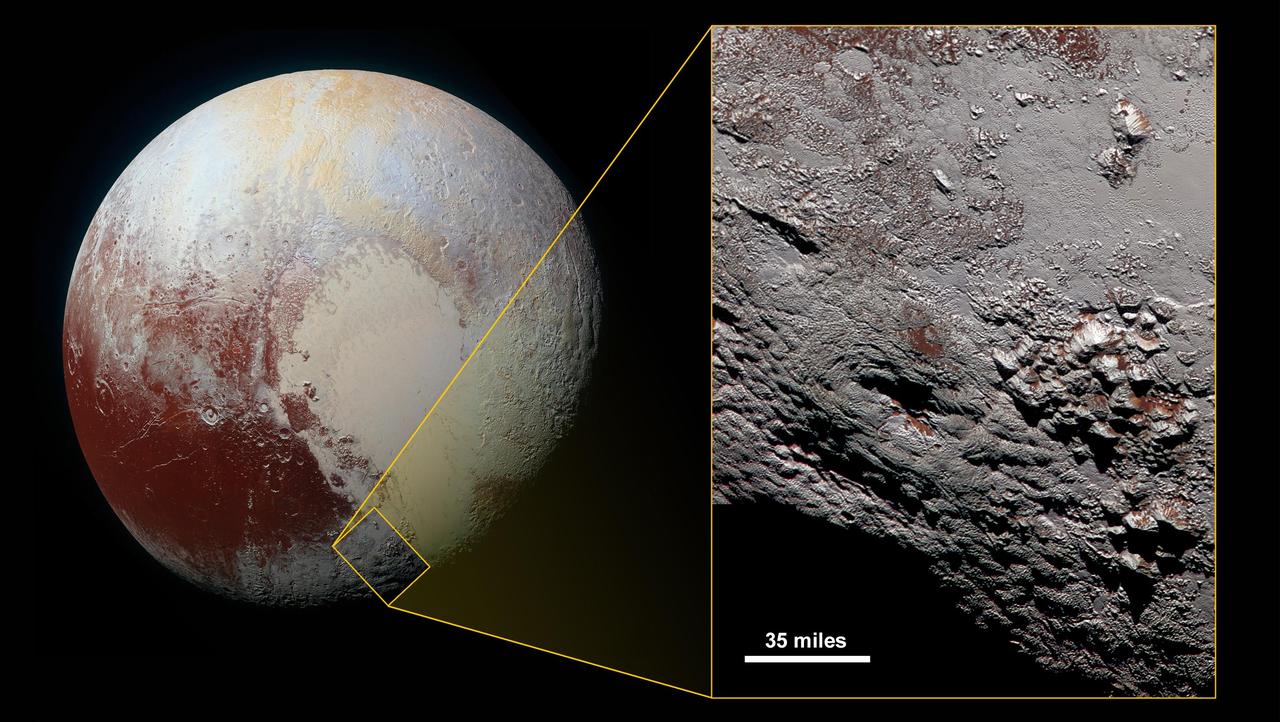A tale of two oceans
Pluto’s next human-made visitor could peel away the world’s surface and reveal an ocean underneath
Rahul Rao • May 6, 2020
For all the frenzy Pluto has ignited in the 21st century, human spacecraft have only visited Pluto and its moons once to date: New Horizons probe, in 2015. But the Southwest Research Institute (SwRI) in Boulder, Colo., announced in October 2019 that it had received NASA funding to begin developing a successor.
While New Horizons only flew past Pluto and its moons, its proposed successor would orbit Pluto, allowing it an extended close look at a world still shrouded in mystery. That look, according to SwRI planetary scientist Kelsi Singer, could find something New Horizons has given tantalizing hints of: an ocean, buried under the surface.
New Horizons’ cameras sighted several clues hinting that an ocean hides beneath the surface. “It’s pretty suspicious,” Singer says.
The biggest such clue — literally — is Sputnik Planitia, a colossal basin frozen over with solid nitrogen. Sputnik Planitia looks like a polar ice cap, but it lies across Pluto’s equator. It’s a large enough dent in Pluto’s surface that it would destabilize the world’s spin — unless it had mass underneath to compensate for the missing surface. A subterranean ocean could explain that mass, according to Francis Nimmo, a planetary scientist at UC Santa Cruz, and his colleagues.
New Horizons also found signs of liquid seeping up from below: fractures across Pluto’s landscape and mountains that scientists think may be cryovolcanoes. While volcanoes on Earth or Venus spew out molten rock, cryovolcanoes spew out molten ice: a blend of water and other chemicals, such as methane and ammonia. That mixture has to come from somewhere underneath.
“None of [the evidence] is bulletproof,” says Nimmo, “but they’re pointing in the same direction” — a buried ocean.
All this leads to the question: in this cold, dark, distant corner of the Solar System, how is that ocean still liquid?
We only need to look at Pluto’s moon Charon to see what scientists think should have happened to its ocean. New Horizons showed that Charon, contrary to being an eternally frozen and dead moon, may once have had a subsurface ocean of its own.
Look at a New Horizons picture of Charon, and you’ll notice that the moon’s southern hemisphere is noticeably smoother than its northern. Planetary scientists like Ross Beyer of the SETI Institute noticed this as well, and hypothesized that the smooth parts were the remnants of an ancient ocean.
Scientists hypothesize that, like Pluto’s, Charon’s ocean would have been made of a mixture of water and other chemicals — in particular, ammonia. When Charon first formed, it would have been warm enough to be liquid.
But, according to Beyer, since Charon didn’t produce enough heat to keep its insides warm, that ocean steadily cooled. Since water freezes at a higher temperature than ammonia, Beyer says it was the water that froze out and exited the mixture at first, and the proportion of ammonia in Charon’s ocean steadily rose.
When the ocean’s ammonia content reached 30%, the molten mixture became less dense than the ice above it, Bayer says. At this point, the subsurface ocean rapidly burst through cracks in the surface — creating the southern surface New Horizons saw. Eventually, Charon froze permanently.
“It all has to do with the story of heat,” says Beyer. “When you run out of heat, you run out of interesting things.”
Pluto’s relatively measly heating should have doomed it to freezing. According to Singer, Pluto produces between 3 and 5 milliwatts of energy for every square meter of its surface. In comparison, an average light bulb can produce many thousands of milliwatts.
According to Singer, scientists think that some moons, like Jupiter’s Europa and Saturn’s Enceladus, have liquid oceans thanks to tidal heating: the effect of gravitational pull of the much larger gas giant churning a moon’s insides. This isn’t the case for Pluto.
If Pluto does have an ocean under its surface, then something within the world must be keeping it liquid. While we can’t see under Pluto again until the next spacecraft arrives, scientists can simulate what lies under Pluto’s surface. Through one such simulation, published in May 2019, some scientists have found one potential solution: gas hydrates, or crystal “cages” of ice which trap gas molecules inside.
“Gas hydrates act as a thermal insulator, so it prevents the complete freezing of the ocean,” says Shunichi Kamata, a planetary scientist at Hokkaido University in Sapporo, Japan, who was involved in the simulation.
Kamata says gas hydrates might form on Pluto as radioactive isotopes decay and heat up inside the core, releasing methane. As that methane rises through the cooling ocean, it would combine with the ice — creating a top layer of gas hydrates that acts as insulation, keeping the ocean warm.
This same idea could also explain why Charon froze. Because Charon is much smaller than Pluto, Charon didn’t have the internal heat required to release its methane. “Consequently, the gas hydrates layer does not exist,” says Kamata, “and the ocean was completely frozen, I would expect.”
Singer calls the gas hydrates “an interesting idea.” A future Pluto orbiter could test this idea, amongst others. For instance, Singer says that, with an orbiter, “you get a good idea of the gravity field, and you can’t do that with a flyby.”
Until then, New Horizons has left us with a pile of unanswered questions. “This always happens,” says Singer, “when we go somewhere new.”
